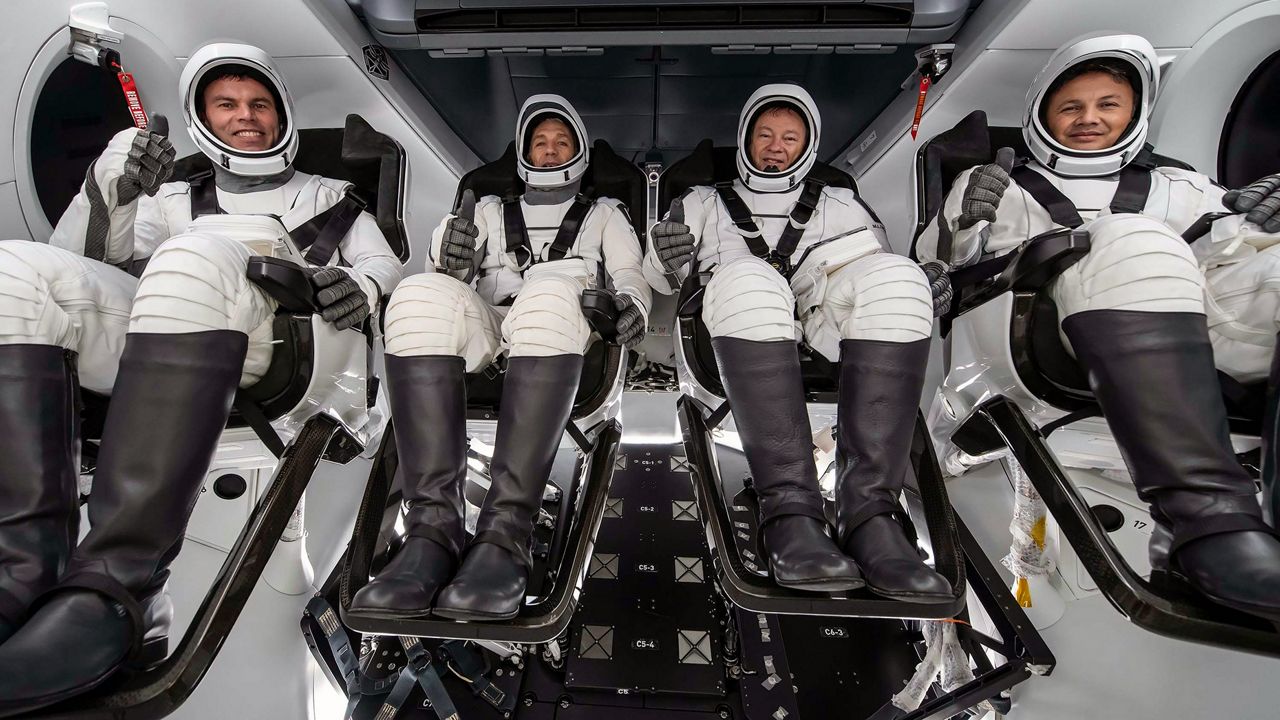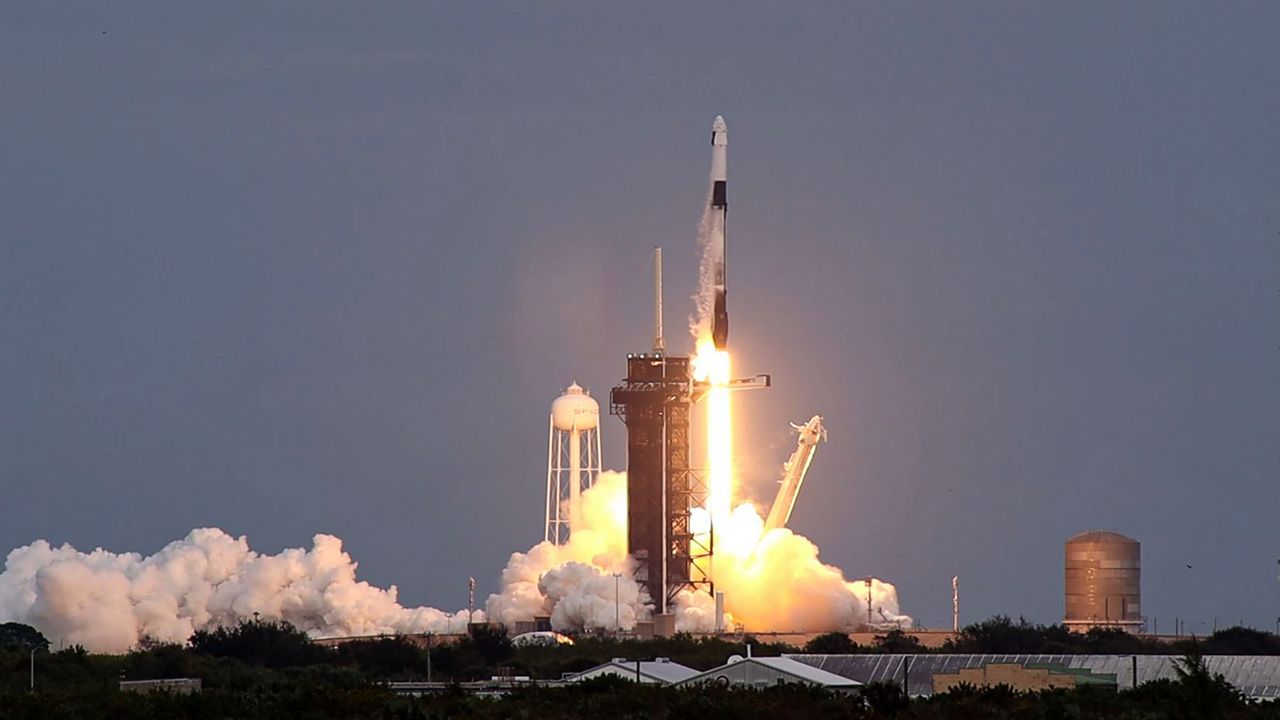CAPE CANAVERAL SPACE FORCE STATION — With cheers from space fans far and wide, SpaceX successfully launched the Axiom Space's Axiom 3 mission to the International Space Station on Thursday afternoon, carrying the first all-European commercial astronauts who will be conducting more than 30 experiments.
What You Need To Know
- Axiom Space is sending the first all-European commercial astronaut mission to the International Space Station Thursday
- The instantaneous launch window opened at 4:49 p.m. ET
- SpaceX’s Falcon 9 rocket left from Launch Complex 39A at NASA’s Kennedy Space Center
- The mission's four astronauts will be conducting more than 30 experiments
- Axiom Space's president shares with Spectrum News how the company is giving chances to go to the ISS
- Get more space coverage here ▶
- 🔻Scroll down to watch the launch🔻
Countdown to launch
🚀With cheers from space fans far and wide, @SpaceX successfully launched @Axiom_Space's #Ax3 mission to the @Space_Station on Thursday afternoon, carrying four men who will be conducting more than 30 experiments.
— 🚀Anthony Leone🌕 (@AnthonyLeone) January 18, 2024
Go to my article at @MyNews13 for more: https://t.co/9Aq0wvYOcG pic.twitter.com/YQE6eC01OH
3, 2, 1
With the roar of the powerful Merlin engines, SpaceX’s Falcon 9 rocket took off from Launch Complex 39A at NASA’s Kennedy Space Center on Thursday, with an instantaneous launch window that opens at 4:49 p.m. ET. It lit the cloudy skies like a Roman candle as it climbed away from home on Earth towards space.
Because this is a crewed launch that is going to the ISS, the first-stage booster landed at SpaceX’s landing zone 1 at Cape Canaveral Space Force Station. Many people far and wide heard the cracking of the sonic boom when it came in for a landing.
In an updated forecast, the 45th Weather Squadron is giving an 80% chance of good liftoff conditions, with the only concern being the cumulus cloud and flight through precipitation rules. The squadron originally gave a favorable 95% chance. Spectrum meteorologist Zach Covey on Thursday stressed the weather may not be so favorable.
The Axiom 3 Launch (Ax-3) has been scrubbed. While official word will be coming from the @Axiom_Space team shortly, I can tell you that the weather at one of the key abort locations is in the RED.
— Zach Covey (@ZachCoveyTV) January 17, 2024
A coastal storm will blow past St. John's today and won't clear out until… pic.twitter.com/hpWBfm9EJG
The Dragon spacecraft, named Freedom, will send Cmdr. Michael López-Alegría, pilot Walter Villadei, and mission specialists Alper Gezeravcı and Marcus Wandt to low-Earth orbit to rendezvous with the ISS.
It will take about a day and a half to journey to the ISS. Once there, the Dragon will dock with the ISS’s Harmony module, according to NASA. It was supposed to originally dock at around 5:15 a.m. ET on Friday, Jan. 19, but since the launch was pushed back, Patrick O'Neil, the public relations officer for the ISS National Lab, told Spectrum News that it will now dock at 4:19 a.m. ET, Saturday.
Freedom has been used for two other missions: Crew-4 in 2022 and Ax-2 in 2023.
The first launch attempt a scrub
The Axiom 3 (Ax-3) mission was originally supposed to go up on Wednesday at 5:11 p.m. ET, but SpaceX posted on X, formally known as Twitter, that it was pushing the launch back to give its team more time to complete pre-launch checkouts and data analysis of its Falcon 9 rocket.
SpaceX did not state why it scrubbed Wednesday evening's first launch attempt, but did state the scrub will give its team more time to complete pre-launch checkouts and data analysis of its Falcon 9 rocket.
Now targeting Thursday, January 18 for launch of the Ax-3 mission to the @space_station. The additional time allows teams to complete pre-launch checkouts and data analysis on the vehicle → https://t.co/bJFjLCiTbK pic.twitter.com/ZL8664RN7D
— SpaceX (@SpaceX) January 17, 2024.
However, Axiom Space stated that besides prelaunch checkouts an data analysis, another item that will be looked into is the "including of the parachute system energy modulator."
During a teleconference on Tuesday, SpaceX's Senior Director of Human Spaceflight Programs Benji Reed described the modulator as straps that attach the parachute bag to the parachute door.
"... Modulators are straps that connect the parachute bag to the parachute door. These straps are folded and stitched together such that when they pull apart, the connecting stitches intentionally break," he explained. "This regulates the load that's applied to the main parachutes which is very important."
During CRS-29 mission, there was a parachute issue and the energy modulator was a contributing factor, he said.
"What we actually believe is a contributing factor to this behavior is a there is a twist in the energy modulator when it is installed before deployment. In its installed state in the vehicle before deployment, if there's a twist in the modulator that could be a contributing factor to what causes this. So what we did is we got into the Axiom-3 vehicle, and we opened up the parachute drawer and we untwisted any of the energy modulators that had any kind of twist in them and we untwisted those proactively to make sure that didn't contribute to that," Reed said.
Learn more about modulators here.
Meeting the crew

“As the first all-European commercial astronaut mission to the International Space Station, Axiom Mission 3 (Ax-3) redefines the pathway to low-Earth orbit for nations around the globe,” the company stated.
The Ax-3 crew hail from all over the world.
López-Alegría is a duel-citizen who will represent Spain and the U.S., while Villadei is from Italy, Gezeravcı hails from Türkiye and Wandt from Sweden and the European Space Agency.
Gezeravcı is the first Turkish astronaut to go into the deep black.
“Türkiye is sending the first Turkish astronaut to space as part of a larger effort to expand the country’s space exploration capabilities and establish a national human spaceflight program,” Alexis DeJarnette, Axiom Space’s public affairs officer, explained to Spectrum News.
In fact, Axiom Space President Matt Ondler explained to Spectrum News the opportunities countries and businesses now have of going to the ISS due to commerical space.
“We think this is probably the future in that, you know, countries want to be involved in space and many have not had the opportunity through the ISS. We are really providing countries this opportunity,” he said.
🚀 @Axiom_Space’s President @mattondler explained to me the opportunities that countries and businesses have now thanks to the commercial space.
— 🚀Anthony Leone🌕 (@AnthonyLeone) January 18, 2024
Learn more about the #Ax3 mission in my article at @MyNews13: https://t.co/7XCyvIBiMd#AxiomSpace pic.twitter.com/rlsglkO2do
If López-Alegría and one of the mission specialists are not able to make the trip up to the famed floating laboratory, there is a backup crew.
- Peggy Whitson will be the backup commander, who was the first woman to command a private space mission, the Ax-2
- Tuva Atasever, who will be a backup mission specialist
The company launched its first two Axiom Space missions from the Sunshine State: Ax-2 in May of 2023 and Ax-1, the first all-private human-crewed spaceflight that took place in April 2022.
Mission Specs:
- SpaceX Falcon 9 rocket: 229.6 feet tall, 12 feet in diameter
- The power: Falcon 9's first stage has nine Merlin engines
- Dragon spacecraft: 26.7 feet, and 13 feet in diameter
- Dragon power: 16 Draco thrusters
- Mission Duration: 14 days
Understanding the mission
This will be the third time the Texas-based Axiom Space has used SpaceX to send astronauts to the ISS.
“The Ax-3 mission is the third of a series of commercial astronaut missions to the International Space Station and a precursor mission to ready for Axiom Station — the world’s first commercial space station,” said DeJarnette.
“This mission marks a new era of opportunity for countries to join the international space community and access low-Earth orbit to advance exploration and research in microgravity,” stated Axiom Space, which has the NASA contract of make new spacesuits for the Artemis III mission.
The four Ax-3 crew members will join the current seven residents of the ISS and will be with them for up to 14 days.
“The Ax-3 quartet will live and work aboard the station for two weeks of research, education, and commercial activities,” NASA stated.
Speaking of research, the four men are bringing with them more than 30 different experiments that will be conducted on behalf of numerous nations’ space agencies, private companies and universities.
“Data collected on ground before and after the mission as well as in flight will impact understanding of human physiology on Earth and on orbit, as well as advance scientific understanding, harness opportunities for industrial advancements, and develop technologies for humanity’s progress,” Axiom Space explained.
DeJarnette noted that Axiom Space has a strong focus on commercial and academic partnership activities as the company provides opportunities for nations, companies and colleges to do research in a low-Earth orbit environment.
Ondler gave an example of some of these opportunities.
This is Sanford Stem Cell Institute’s third time going to the ISS, thanks to Axiom Space. Because of microgravity, there are things that can be done with stem cells that cannot be done on Earth, he explained. The hope is that one day these cells can be used to fight cancer.
“I think 15, 20 years from now, we are going to be surrounded by objects that we can’t imagine how we live without that were manufactured in space,” he said.
Tejpaul Bhatia, Axiom Space's chief revenue officer, noted how space is the next big economic market.
“The next big step is going to be this new revolution, economic revolution, that we know is coming, whether this is parallel to the internet in the 90s, we know that space, microgravity, low-Earth orbit and then further exploration, is really going to change and revolutionize business for us. And this is happening due to a public/private partnership unlike any in human history. It’s not that NASA or ESA (European Space Agency), who are major stakeholders in this mission, are handing over the torch. We are sharing in that torch,” he said to Spectrum News.
So, grab a cup of coffee and enjoy perusing those experiments here.
Axiom Space’s future
The next mission for the company, Ax-4, is expected later this year, DeJarnette said.
“NASA and Axiom Space have signed a mission order for the fourth private astronaut mission to the International Space Station, targeted to launch no earlier than October 2024 from the agency’s NASA’s Kennedy Space Center in Florida,” she said.
In addition, the company’s space station — Axiom Station — and its construction are ongoing, with the first module expected to be to be launched to the ISS in 2026.
Ondler shared more about Axiom Station's progress and its future plans.
“We’re currently building our commercial space station. The first modules are being built,” he said, adding that the hope is that the first module will be launched to the ISS in 2026.
From there, more Axiom Space modules will be added to each other.
“That first module will attach to the ISS and then we will add three more modules before we separate to the ISS toward the end of the decade,” he explained.
He said the Axiom Station will be akin to how SpaceX sends people and equipment to space. He said NASA can send cargo up at a much lower cost since retiring the space shuttle and using SpaceX.
“Where there is a commercial alternative, NASA can still use that space station but it frees up a bunch of money for NASA to spend on going to the moon and Mars,” he said.



